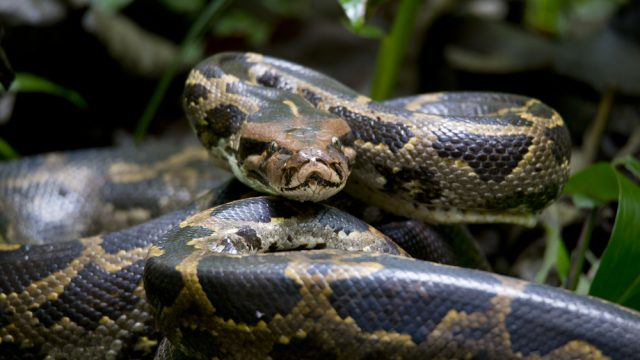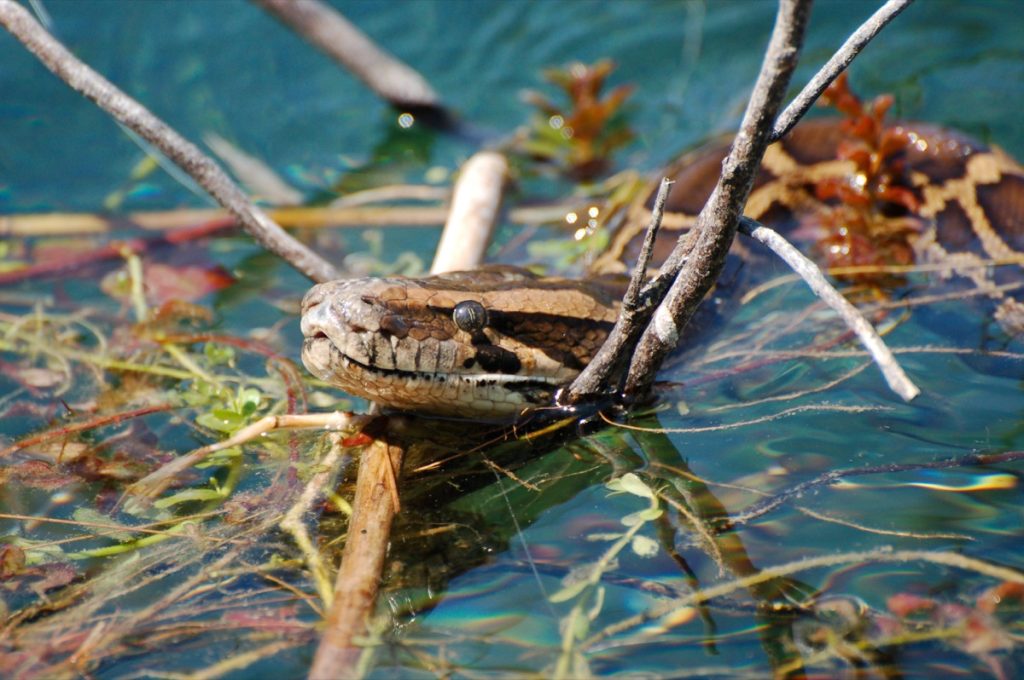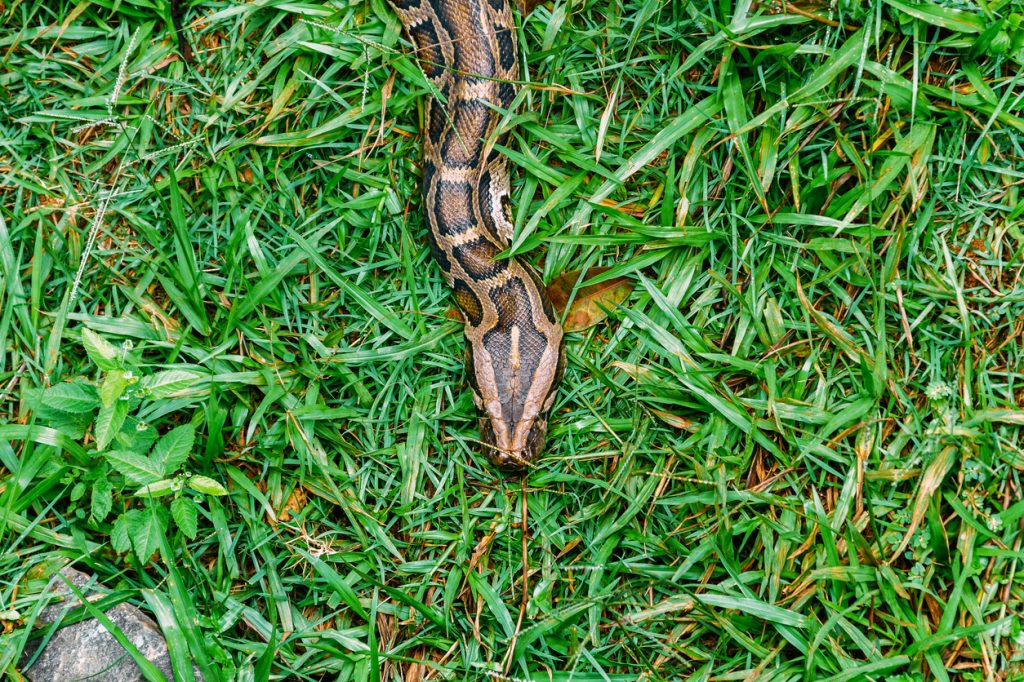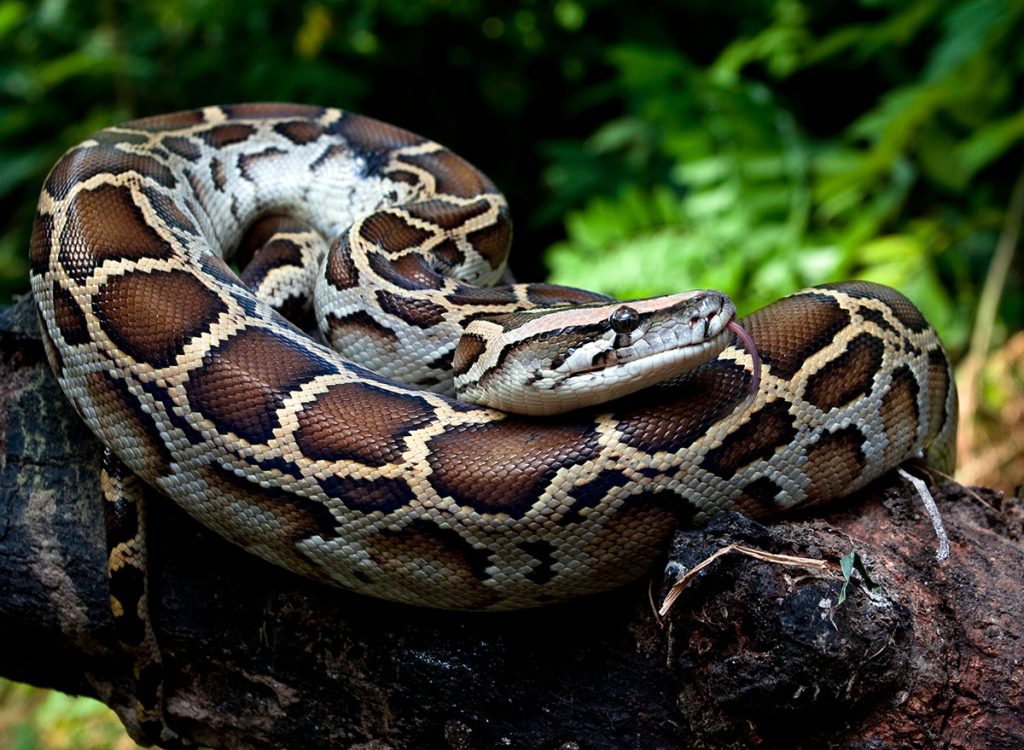Invasive 200-Pound Pythons Are Spreading in the U.S.—And Eradication "Is Not Possible"
The snakes are wreaking havoc on local ecosystems and threatening to wipe out indigenous species.

Even with the seemingly infinite number of plant and animal species that inhabit it, the natural world as we know it exists thanks to a delicate balance that helps keep it thriving. Unfortunately, this means that even small changes can upend or threaten an area's ecological stability, whether due to climate change, habitat destruction, or the introduction of an invasive species. And now, officials are warning that 200-pound pythons not typically found in the U.S. are beginning to spread into even more areas. Read on to see why the snakes pose such a serious problem—and why experts say eradication "is not possible" now.
READ THIS NEXT: The No. 1 Way to Keep Snakes From Getting in Through Your Toilet.
Invasive Burmese pythons are spreading in the U.S. after they were introduced to the ecosystem.

Part of the beauty of nature is that unique plants and animals adapt to the conditions of different places in order to thrive. But in Florida, an invasive species of Burmese pythons has been wreaking havoc on ecosystems as it spreads into new areas.
In a recent report, scientists with the U.S. Geological Survey (USGS) say the snakes have been increasing in number and threatening local wildlife, according to The New York Times. Researchers say that some of the specimens collected in recent years have grown to be heavier than 200 pounds and longer than 15 feet, with evidence found in their digestive tracts establishing a list of at least 76 prey species of mammals, birds, and even alligators.
The non-native apex predators have expanded their presence from the marshy Everglades on the southern tip of Florida as they push further north into areas such as Fort Myers and West Palm Beach. But researchers also noted that the reptiles are expanding their new territory even further thanks to the unique terrain in Florida and an increased cold tolerance that allows them to withstand lower temperatures.
"Overall, potential range limits of Burmese pythons are uncertain," the team wrote in the study.
Despite recent efforts, researchers now say that eradication of the invasive snake "is not possible."

Officials have noted the spread of the invasive snakes since 2000, when the likely former pets were released into the wild and began reproducing, per The New York Times. But the number of reported pythons has continued to skyrocket in the ensuing two decades, from three at the start of the millennium to a height of 2,940 in 2020, according to state data.
However, the snake's actual population count has been difficult to gauge accurately and is likely much more extensive than estimated, making it harder to get a true grasp of the problem. "Extremely low individual python detection rates hamper our ability to both estimate python abundance and expand control tools across the extensive natural landscape," Kristen Hart, a research ecologist with USGS and one of the authors of the recent report, said in a press release.
In response to the growing threat to local ecosystems, officials in Florida have launched an annual hunt open to the public that uses cash prizes to incentivize participants. Those taking part must first complete training on how to safely and humanely locate and euthanize the animals they retrieve. But despite the yearly event, the culling will unlikely be enough to slow the snake's spread.
"Eradication of the entire population across the landscape is not possible with any existing tools, whether applied singly or in combination," the researchers wrote in the report.
RELATED: For more up-to-date information, sign up for our daily newsletter.
Experts warn the reptiles will continue to spread unless something is done to slow them down.

The researchers point out that the gigantic reptiles pose little threat to human safety, with the only reported human deaths related to captive pythons. But the snakes remain a serious problem for the delicate ecosystems they now inhabit—especially as medium-sized predators such as foxes, raccoons, and opossums are hunted by the invasive species and removed from the food chain.
"This means that larger predators are missing a major food source, and the things that these smaller mammals feed on are going to have a population boom," Charles van Rees, PhD, conservation scientist and naturalist at the University of Georgia, tells Best Life. He also adds that specific species are particularly threatened, including an endangered rabbit found only in Florida that is "at risk of being snuffed out by excessive predation from this snake."
Unfortunately, the current trajectory of the problem means the pythons will continue to expand their territory. "If left totally unmitigated, this is very unlikely to remain a Florida problem," van Rees says.
Even though many have counted on colder winters in parts of the state to act as a significant barrier to their spread, he states that issues such as climate change are making temperatures much milder in areas to the north. "The problem is absolutely going to grow if we don't do anything about it. And if eradication is no longer possible, smart investment right now can help keep this problem from spreading. "
Officials are trying new tactics to help control the python's population growth.

Due to the looming ecological threat they pose, researchers are now trying new tactics to help rein in the snake's spread in the region. One group of scientists is using GPS collars attached to prey and male snakes to help locate harder-to-find females, The Guardian reported last month. And officials in Florida have launched a hotline residents can use to report the reptiles for removal. But even as some hope to eventually used more advanced tactics, there's no question that action is necessary.
"I don't think there is any scenario in which nothing can be done," van Rees tells Best Life. "That being said, all of our solutions are now in a gray area of tradeoffs between how much of Florida's ecological integrity we want to keep around and how much we're willing to spend to keep it. Managing invasive species is extremely expensive, and you have to do it forever."
This likely means the overall strategy should shift. "If we can't eradicate pythons, then we have to start managing them," he says. "Can we keep them out of certain areas where we want to protect key wildlife? Can we keep their populations relatively low so that they aren't totally annihilating our irreplaceable natural heritage? The worst case scenario is to do nothing and let things continue as they are."





















